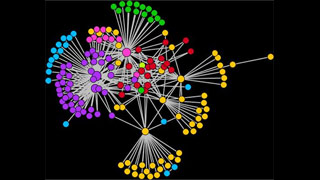We like to think of the human brain as special, but as we reported on Plus last year, it has quite a lot in common with worm brains and even with high-performance computer circuits. But how does it compare to online social networks?
In a recent lecture at the Cambridge Science Festival the psychiatrist Ed Bullmore, on whose research our article was based, put this question to the test. He asked the audience and other Twitter users to tweet during the lecture about the concepts that were being discussed, using the hashtag #csftwitterbrain. At the end of the talk Bullmore displayed the resulting image showing the interconnectivity of the hashtagged tweets, and explained how Twitter networks can be compared to the network formed by interconnected regions of the human brain.

Representation of the #twitterbrain hashtag following lecture tweets. The lines between the dots represent relationships between users. The circles at the centre of starbursts show Twitter users that have been re-tweeted by their followers.
Like the human brain, the #twitterbrain turned out to be a small world network, meaning that the paths linking any two nodes are relatively short and that there's a high degree of local clustering. This means that information can get around quickly, both over short and long distances, so it makes sense for any information processing network to evolve this feature.
Also like the human brain network, the #twitterbrain network was modular, meaning that its overall architecture can be broken up into a number of modules containing nodes that are densly connected to each other, but sparsely connected to nodes in other modules. "It's been suggested that modularity is advantageous to any information processing system that has to adapt, evolve, or change," says Bullmore. "This is because modularity allows a complex system to change one module at a time without threatening function in other modules."
"We found that the #twitterbrain network was somewhat like the brain network in being small-world and modular with highly connected hub nodes; however the brain network was more clustered and less efficient than the Twitter network. So at first sight there were some points in common and some points of difference between these two information processing networks."

A human brain network.
"One possible explanation for the differences is that the human brain is embedded in physical space and will nearly minimise connection cost," says Bullmore. Long distance connections between regions of the brain actually cost quite a lot in terms of metabolic energy and the brain has evolved to keep this connection cost down."The Twitter network [on the other hand] is likely to be less constrained by the extra cost of making longer distance connections (tweets) between people."
Bullmore believes that the difficult trade-off between the complexity needed to ensure high performance and the connection cost that comes with this complexity is what has caused the brain to evolve a particular mathematical structure, known as Rent's rule. It is found not just in the human brain network, but also in the nervous system of a nematode worm and high-performance computing circuits. (You can find out more about this research in the article Wiring up brains.)
Bullmore's Twitter experiment was designed to engage his audience at the Cambridge Science Festival. "It has been intriguing to see the spectacle of watching the Twitter network grow or evolve over the course of several days. And I have learnt a lot about the power of new media to engage and communicate, and the potential scientific value of using Twitter to map and measure social networks." But the experiment also illustrates just how fruitful the new approach can be. Regarding the brain as a network not only puts a range of mathematical tools from network theory at researchers' disposal, but it also allows them to compare brains to the wide variety of other networks, to look for similarities and differences.